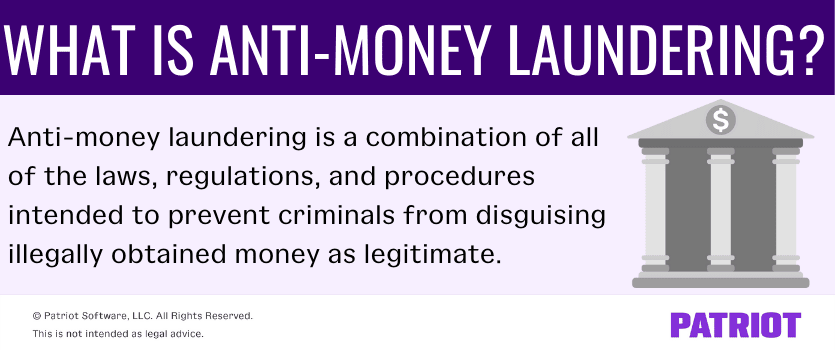The idea of money laundering can be scary to employers. Illegal transfers of funds can harm businesses, after all. So, be on guard and aware of different protections meant to prevent money laundering. One of those protections is anti-money laundering.
What is anti-money laundering?
Before discussing what anti-money laundering (AML) is, understand what is money laundering.
Money laundering is the illegal act of making large amounts of money from criminal activity appear to come from legitimate sources. The money from criminal activity is “dirty” money. The process of making it look like it came from a legitimate source then “launders” the funds to make them look “clean.” Hence, the term money laundering.
So, what is anti-money laundering? Anti-money laundering describes all the laws, regulations, and procedures intended to prevent criminals from disguising illegally obtained money as legitimate. Anti-money laundering regulations help with preventing money laundering.

In 1989, countries around the globe banded together to form the Financial Action Task Force (FATF). Following the September 11, 2001 terrorist attacks, the FATF included combating terrorist financing in its mission. The International Monetary Fund (IMF) oversees Anti-money Laundering/Combating the Financing of Terrorism (AML/CFT) efforts by setting controls.
AML compliance
Criminals engaging in illegal activity may focus on ensuring their illegal funds look legitimate when passing through financial institutions. Anti-money laundering laws and regulations target criminal activities, the methods used to conceal the crimes, and the money from those crimes. So, compliance with the regulations helps prevent money laundering.
One common tactic in AML is holding funds. There is an AML holding period that requires deposits to remain in an account for a minimum period of five trading days. The intention of a holding period is to help with risk management and anti-money laundering.
As a business owner, you may see the effects of AML compliance in different ways. For example, financial institutions may require you to follow specific rules and procedures to ensure your business is not aiding in money laundering. You may agree to follow these rules if you accept lines of credit from your bank or accept customer deposits.
Anti-money laundering best practices
Companies have a number of ways of weeding out potentially risky customers. One of the most common ways financial institutions do this is using a process known as Know Your Customer (KYC) or Know Your Client.
The Know Your Customer Rule 2020 is an ethical rule which states that every broker-dealer should use reasonable effort when opening and maintaining client accounts. Broker-dealers must know and keep records on the essential facts of each customer. And, they should identify each person who has the authority to act on the customer’s behalf.
In short, the institution must know specific information about the clients to ensure that the customer is who they say they are. The process allows the broker to establish essential facts beforehand so that they can service the account effectively.
Businesses must also do their due diligence to comply with anti-money laundering best practices. According to Gabriel Dungan, CEO and Founder of ViscoSoft, compliance officers are a useful tool:
Complying with anti-money laundering rules and regulations is crucial for business longevity and growth. My biggest piece of advice for business owners would be to ensure there is proper training in anti-money laundering compliance for all members of staff that deal with anything financial.
If you have the funds, I recommend hiring a compliance officer. An AML compliance officer can design and oversee training for all relevant members of staff and also act as a liaison between staff and management. Having someone who can specifically ensure your business is complying with policies will really mitigate the risk of any costly repercussions or issues.”
Along with utilizing compliance officers, businesses can also do the following to prevent money laundering:
- Have employees complete training regularly
- Be familiar with the KYC rules
- Track all transactions (e.g., use accounting software and import banking information)
- Use multi-factor authentication (MFA) for all financial applications and websites, if possible
Looking for more information on accounting and finances?
Get the latest accounting news delivered straight to your inbox.
Subscribe to Email ListWho oversees anti-money laundering procedures?
Financial institutions are at the forefront of monitoring and overseeing anti-money laundering. The institutions monitor customer deposits and other financial transactions to ensure that the funds are not part of a money-laundering scheme.
To ensure that funds are not part of a scheme, financial institutions verify the origins of large financial sums, monitor all suspicious activity, and report cash transactions exceeding $10,000. For each transaction over $10,000, financial institutions must file a currency transaction report (CRT). And, they must also report other activity deemed suspicious on a suspicious activity report (SAR).
But, why is $10,000 the limit to trigger a report? In 1970, the federal government signed the Bank Secrecy Act of 1970 into law. Under the law, financial institutions must report the names and Social Security numbers of individuals who deposit cash amounts exceeding $10,000. The $10,000 limit is to ensure that the privacy of most citizens is not invaded.
When the financial institutions report suspicious or illegal activity, the federal government investigates. Both the FBI and the Department of the Treasury investigate money-laundering schemes. The Treasury Department uses the Office of Terrorism and Financial Intelligence (TFI) to investigate these crimes.
Money laundering and cryptocurrency
Money laundering is not a new crime. But, using digital forms of currency to launder funds is new. And, so is the ability to launder funds using online sources, such as online payment services, banks, auctions, sales, and more.
Because online payments and cryptocurrency are so new, it’s even more important to track all of your transactions carefully. The laws are currently designed to only monitor and track transactions through traditional banking institutions. So if you decide to use digital platforms or currency, keep a careful record in your books. For example, learn how to process cryptocurrency in accounting to ensure you have all the information necessary.
How to detect and prevent money laundering in your business
There are a few ways you can protect your business from money-laundering schemes. AML regulations should be in place wherever you transfer money. Let’s look at some examples of how to detect and prevent anti-money laundering in your business.
Example 1
You use payroll software to pay your employees’ wages. The payroll service provider uses multi-factor authentication to protect your account. With MFA, you receive a specialized one-time use code to your phone or email.
One day, you receive the code on your phone, but you did not try to log into your account that day. You call your provider and determine that someone you did not authorize tried to access your account.
The MFA is a way to prevent money laundering because it helps block unauthorized individuals from your account. In turn, they cannot move your legitimate funds to unauthorized accounts.
Example 2
Say you do not have any employees and do not need payroll software. One day, you see a small transaction on your bank statement from a payroll software company. You contact the company and determine someone opened an account under your business’s name in an effort to show illegal funds passing through a legitimate business. So, you contact your bank and inform them of the circumstances.
In this example, the payroll provider used KYC protocols to make a small deposit and withdrawal to verify the banking information. By checking your bank statements, you detected these transactions and took steps to prevent money laundering.
Example 3
After you hire employees, you decide to use payroll software to pay them their wages. And, you choose to use direct deposit.
Your new payroll provider requires you to verify your identity and banking information to use direct deposit. To verify your bank account, the provider requires a recent bank statement. You submit a letter from your bank that contains information about opening the business bank account, but the provider must reject the letter. Why? Because KYC requires the use of a standardized letter with the contact information of a member of the financial institution or a recent bank statement.
The payroll provider is using AML best practices to ensure the information is legitimate and protect your business from potential fraud.
This is not intended as legal advice; for more information, please click here.





